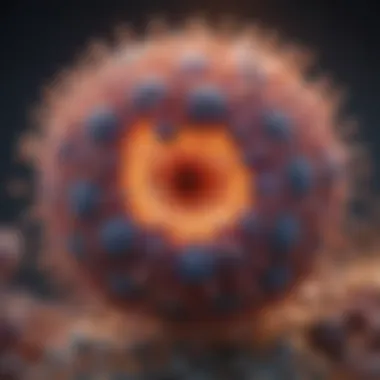Herpes Simplex Vaccine Research: Current Insights


Intro
Herpes simplex virus (HSV) represents a significant health challenge worldwide. The virus manifests in two primary forms: HSV-1, predominantly causing oral infections, and HSV-2, primarily associated with genital infections. The complexities involved in developing an effective vaccine stem from the virus's biological characteristics, global prevalence, and the social stigma surrounding herpes. This article aims to shed light on ongoing research efforts for HSV vaccination, exploring recent advancements, identifying hurdles, and evaluating implications for public health.
Research Overview
Summary of key findings
Recent studies have focused on different vaccine candidates that target both varieties of the herpes simplex virus. Preliminary results point towards a few promising avenues, such as live attenuated vaccines, protein subunit approaches, and novel mRNA technologies. One major finding is a heightened immune response observed in Phase I trials, suggesting potential effectiveness in protecting against HSV-1 and HSV-2 infections.
Moreover, researchers also emphasize the importance of mucosal immunity. This form of immunity plays a crucial role in combatting HSV, as the virus typically enters through mucosal surfaces. Current vaccine designs increasingly focus on inducing a robust mucosal immune response, improving chances for preventing initial infection as well as reactivation of dormant virus.
Importance of the research in its respective field
The development of a herpes simplex vaccine is critical. Currently, HSV affects billions worldwide, leading to considerable social and psychological burdens. Vaccine solutions may alleviate not only physical symptoms but also help tackle associated stigma. By effectively controlling HSV spread, public health outcomes can be greatly enhanced.
Furthermore, the exploration of a herpes vaccine facilitates discussions on broader vaccine technology advancements. Lessons learned in this arena may have implications for other viral diseases as well, enhancing overall viral vaccine strategies.
Methodology
Description of the experimental or analytical methods used
Research studies on HSV vaccine candidates typically employ a combination of laboratory and clinical methodologies. In vitro studies evaluate immune responses and possible side effects, while in vivo experiments, often conducted on animal models, help ascertain the vaccine’s efficacy and safety before human trials begin. The studies also utilize advanced techniques like next-generation sequencing to analyze immune responses.
Sampling criteria and data collection techniques
Human clinical trials involve strict criteria to ensure diverse participant representation. Candidates chosen for participation often have a documented history of herpes simplex infections, or they may be seronegative individuals without previous exposure to HSV. Data collection includes monitoring immune response levels, adverse reactions, and long-term efficacy outcomes from ongoing injections or booster shots. Clinical data is gathered through questionnaires, physical examinations, and laboratory tests.
Continuous efforts in vaccine research not only aim to find effective preventative measures but also strive to improve overall public perception and fight misinformation surrounding herpes simplex virus.
This multidimensional approach ensures a comprehensive understanding of both the virus and potential vaccine candidates, paving the way for future breakthroughs in herpes simplex prevention and control.
Prolusion to Herpes Simplex Virus
Understanding the herpes simplex virus (HSV) is crucial in the quest for developing an effective vaccine. The impact of HSV on individuals and society at large warrants a closer look. This virus, which can cause lifelong infections, has significant implications for both public health and the medical community. As we delve into the intricacies of this virus, it is essential to comprehend its types, modes of transmission, and global prevalence. Such insights can guide vaccine development efforts, highlighting the path forward to potentially eliminate or reduce the burden of HSV.
Overview of Herpes Simplex Virus Types
Herpes simplex virus is primarily categorized into two distinct types: HSV-1 and HSV-2. Each of these types can cause various clinical manifestations and complications.
- HSV-1: Often associated with oral herpes, it is typically known for causing cold sores around the mouth. However, it can also lead to genital infections, which can be misleading since many individuals are not aware they carry this type. With increasing frequency, HSV-1 is being recognized as a growing cause of genital herpes due to changing sexual practices.
- HSV-2: This type is most commonly linked with genital herpes. It correlates with recurrent outbreaks and is a substantial source of stigma. Infected individuals face significant challenges regarding psychological well-being and social interactions. Both types of HSV exhibit similar structures and are contagious even when symptoms are not present, which complicates public health efforts aimed at controlling their spread.
Understanding these differences is fundamental for researchers and health professionals as they work towards a potential vaccine.
Epidemiology and Global Prevalence
The epidemiology of herpes simplex virus paints a concerning picture. Globally, it is estimated that more than 3.7 billion people are infected with HSV-1, while approximately 491 million individuals have HSV-2. These statistics highlight the widespread nature of the virus.


Factors contributing to its prevalence include:
- High transmission rates: The virus can be easily transmitted through skin-to-skin contact, meaning that it often spreads swiftly in populations.
- Lack of awareness: Many carriers of HSV are unaware they are infected, leading to unintentional transmission.
- Cultural factors: Stigma associated with HSV complicates discussions about sexual health and prevention.
- Geographical variations: The prevalence of HSV-2 varies significantly across regions, with higher rates reported in developing countries compared to developed nations.
"Herpes simplex virus continues to be a major public health challenge worldwide, affecting millions and complicating personal relationships".
To mitigate the impact of HSV, understanding epidemiological trends is vital for the development of targeted awareness and prevention strategies. Every aspect, from understanding the types to grasping the extent of its spread, lays the groundwork for future advancements in vaccine research.
The Immune Response to HSV
The immune response to the herpes simplex virus (HSV) is a critical area of study in both virology and vaccine development. Understanding how the human body reacts to HSV infection can help researchers design effective vaccines. This vaccine, if developed, can prevent both initial infections and recurrent outbreaks. The immune response is divided into two main categories: innate immune response and adaptive immune response. Each plays a distinct yet interconnected role in how the body fights against HSV.
Innate Immune Response Mechanisms
The innate immune response is the body’s first line of defense against pathogens like HSV. It is a non-specific response, meaning it does not target just one type of pathogen. Instead, it responds to common features of invaders. The mechanisms include various cells and proteins that act quickly upon infection.
- Physical Barriers: The skin and mucosal surfaces act as barriers that prevent HSV from entering the body. When these barriers are breached, other innate responses are activated.
- Phagocytic Cells: Cells such as macrophages and neutrophils engulf and destroy HSV-infected cells. They recognize infected cells through pattern recognition receptors that detect viral components.
- Interferons: These are signaling proteins that play a crucial role in the antiviral response. They can inhibit viral replication, enhance the activity of immune cells, and increase the resistance of neighboring cells to infection.
- Natural Killer Cells: These specialized lymphocytes can detect and kill virus-infected cells directly. Their activity is essential in controlling HSV until the adaptive immune response kicks in.
The importance of the innate immune response lies in its speed and initial control of the virus, setting the stage for a more specific response initiated by the adaptive immune system.
Adaptive Immune Response and Limitations
The adaptive immune response is characterized by its specificity and memory, allowing for a more effective response upon subsequent exposures to HSV. This involves two main types of immune cells: T cells and B cells.
- T Cells: After infection, CD8+ cytotoxic T lymphocytes identify and kill infected cells. They play a vital role in controlling HSV reactivation. CD4+ helper T cells support B cells and cytotoxic T cells, enhancing the immune response's effectiveness.
- B Cells: These cells produce antibodies specific to HSV. The antibodies can neutralize the virus, preventing it from infecting new cells and facilitating the clearance of infected cells.
Despite these beneficial roles, there are limitations to the adaptive immune response against HSV:
- Latency: HSV establishes latency in sensory neurons, allowing it to evade the immune system. Once latent, the virus can reactivate, causing recurrent symptoms.
- Incomplete Immunity: While the adaptive response can control the virus, it rarely provides complete protection. This is evident in individuals who experience recurrent outbreaks despite having an immune response.
"Understanding the immune response to HSV is essential for vaccine development. The interplay between innate and adaptive responses is a key factor in controlling the virus."
In summary, both the innate and adaptive immune responses are critical for understanding how the body combats HSV. Insights from these immune mechanisms are fundamental for developing effective vaccines, which could potentially reduce the disease burden associated with herpes simplex virus infections.
Challenges in Developing a Herpes Vaccine
The prospect of creating a vaccine against the herpes simplex virus (HSV) is fraught with numerous challenges that complicate the development process. Understanding these challenges is crucial, as they highlight the intricate nature of the virus and the multifaceted approaches needed for effective vaccine design. This section will delve into the primary hurdles faced by researchers, emphasizing their significance in shaping current scientific efforts.
Viral Evasion Strategies
One of the foremost challenges in developing a herpes vaccine lies in the virus's ability to evade the immune system. HSV possesses several mechanisms that allow it to persist within the host, often leading to recurrent infections. For example, the virus can establish latency in nerve cells, where it remains hidden from the immune response. This latency makes it difficult for the immune system to target and eliminate the virus completely.
HSV can also alter its surface proteins, which helps it avoid detection by immune cells. This capability poses a significant obstacle for vaccine development. A successful vaccine must prompt an immune response robust enough to recognize and attack these varied forms of the virus. If the immune response is too narrowly focused, it may not offer protection against all strains of the virus.
Moreover, the virus manipulates the host's immune response by producing proteins that inhibit the action of interferons and other antiviral substances. This immune suppression adds another layer of complexity to vaccine efficacy, as the immune response may be insufficient to clear the virus, even if a strong initial response is generated during vaccination.
Historical Attempts and Failures


Throughout history, there have been numerous attempts to create an effective herpes vaccine. Most of these efforts have faced significant difficulties, leading to disappointing results. Early vaccine candidates focused on using whole, inactivated virus or live attenuated virus strategies, but these approaches often led to inadequate immune responses or safety concerns.
For instance, the 2008 trial of the Glybera vaccine demonstrated how challenging the task can be. Although it aimed to prevent genital herpes, various issues with the formulation and the immune response led to its non-approval by regulatory bodies. Another noteworthy study, the vaccine developed by Genital Herpes Vaccine (GHV), also failed to show sufficient efficacy in clinical trials.
These examples illuminate the difficulties faced in achieving the delicate balance between inducing a strong immune response and ensuring safety. The various types of HSV and their complex biology mean that a one-size-fits-all approach is unlikely to succeed.
"No vaccine has achieved sufficient efficacy against herpes simplex virus to be adopted for public use. The difficulty in evasion strategies and previous failures reflect the complexity of this task."
In summary, the challenges in developing a herpes vaccine stem from the virus's sophisticated evasion tactics and the historical failures of previous attempts. Addressing these issues remains paramount for future efforts, requiring innovative strategies and thorough understanding of the virus's biology. A successful vaccine could revolutionize the approach to herpes and significantly impact public health on a global scale.
Current HSV Vaccine Research
The topic of current HSV vaccine research is vital in understanding the ongoing efforts aimed at controlling and potentially eradicating herpes simplex virus (HSV). The implications of successful vaccine development stretch beyond individual health, touching public health initiatives, societal stigma, and health economics. Recent advancements in this field have sparked optimism and provided new directions and strategies for the fight against HSV.
Progress in Clinical Trials
Recent years have seen a surge in clinical trial activity focused on HSV vaccines. Several promising candidates are currently undergoing rigorous testing. For example, the GSK's HSV-2 vaccine candidate, which demonstrated safety in early phases, is one such example. In trials, researchers monitor the immune response generated by these candidates to determine if they are effective in preventing transmission or reducing outbreaks. This is a complex process that requires careful design and execution, balancing efficacy with safety.
The success of these trials could light the path for broader vaccination strategies. By confirming the safety and efficacy of the vaccine candidates, researchers can address concerns about reliability and public acceptance. Further studies are needed to assess long-term effects and optimal dosing schedules.
Innovative Approaches in Vaccine Design
Innovation plays a crucial role in the development of HSV vaccines. Researchers are exploring diverse platforms for vaccine development, such as mRNA technology, viral vectors, and protein subunit approaches. These methodologies each offer unique benefits. For instance, mRNA vaccines are noted for their speed of production and adaptability. They have been instrumental during the COVID-19 pandemic and present an exciting avenue for HSV vaccine research.
Another important approach involves the use of adjuvants, which enhance the body’s immune response to the vaccine. Researchers are evaluating various adjuvants to find the most effective combinations. These innovative design approaches are essential for crafting a robust vaccine capable of addressing the unique challenges presented by HSV.
Case Studies of Noteworthy Research
Evaluating noteworthy research provides insight into the landscape of HSV vaccine development. A significant case is the research led by the Harvard Medical School team, which focuses on using the live-attenuated vaccine strategy. Their studies indicate that a modified version of the virus may elicit a more robust immune response compared to traditional methods.
Moreover, the work by the University of California, San Diego, has pioneered advancements in needle-free delivery systems for vaccines. These systems potentially improve vaccine uptake and compliance by minimizing pain.
Both of these case studies exemplify the innovative spirit in the field. Many research groups around the world are pushing boundaries, exploring unique methods and strategies to expedite the availability of an HSV vaccine, creating optimism for future developments.
As the research continues to advance, the hope for a herpes simplex vaccine becomes more tangible, underscoring the need for robust and innovative methodologies in vaccine research.
Implications of a Herpes Vaccine
The development of a herpes simplex virus vaccine carries significant implications for both individual and public health. Understanding these implications allows stakeholders, including researchers, healthcare providers, and policymakers, to appreciate the potential benefits of such a vaccine. In this section, we will explore its impact—primarily on public health initiatives and the prevailing stigma associated with herpes infections.
Impact on Public Health Initiatives
Public health initiatives aim to improve the overall well-being of populations. A herpes simplex vaccine could fundamentally alter the trajectory of herpes transmission and infection rates. Currently, HSV affects a large portion of the global population, causing not just health issues but also social and psychological burdens. Vaccination could help reduce infection rates by creating herd immunity, thereby protecting those who are most vulnerable and cannot be vaccinated.
- Reduction of Transmission: A vaccine would directly decrease the incidence of new infections, limiting the number of individuals who may experience severe symptoms or complications.
- Cost-Effectiveness: With fewer infections, healthcare costs associated with managing HSV could decrease. This includes reduced expenditures on antiviral medications and healthcare visits, ultimately benefiting healthcare systems.
- Educational Opportunities: Successful implementation of a herpes vaccine program can be paired with educational campaigns that raise awareness about sexual health, responsible behaviors, and the realities of living with herpes.
In summary, a herpes simplex vaccine has the potential to enhance public health initiatives by decreasing transmission, reducing costs, and offering educational outreach.


Potential to Reduce Stigma
The stigma surrounding herpes simplex virus infections poses challenges for those affected. Many individuals fear social isolation, judgment, and emotional distress associated with their diagnosis. A vaccine could provide a powerful means of reducing this stigma.
"A vaccine not only protects individuals but could change societal perceptions about herpes, allowing people to discuss it more openly."
- Changing the Narrative: Widespread vaccination might shift the conversation away from fear and shame, towards a rational understanding of HSV as a manageable condition, similar to other vaccine-preventable diseases.
- Encouraging Disclosure: As vaccination normalizes the conversation around HSV, individuals may feel less inclined to hide their status, leading to heightened acceptance and understanding.
- Supporting Affected Individuals: Reducing stigma encourages affected individuals to seek medical care, participate in support groups, and engage in open dialogues with partners
The implications of a herpes vaccine extend beyond individual protection; they reach into the domains of public health and social attitudes. Through comprehensive vaccination efforts, there is potential for profound change in how society perceives and addresses herpes simplex virus infections.
Future Directions in HSV Vaccine Development
Vaccine development for herpes simplex virus (HSV) remains a significant focus in the field of infectious diseases. Understanding the future directions in this area is crucial. With the prevalence of HSV infections globally, effective vaccines would have profound impacts on public health, disease management, and stigma reduction associated with the virus. This section will delve into new approaches and collaborative efforts shaping the landscape of HSV vaccine research.
Advancements in Biotechnology
Biotechnology is driving new frontiers in vaccine research. With the advent of genetic engineering and molecular biology, researchers are exploring various innovative strategies, which include:
- mRNA Technology: Inspired by the success of COVID-19 vaccines, mRNA technology is at the forefront. Researchers are investigating the potential of mRNA vaccines to create a specific immune response against HSV.
- Viral Vector Vaccines: Utilizing harmless viruses to deliver HSV antigens presents another avenue. These vectors can provoke a robust immune response without causing disease.
- Subunit Vaccines: By isolating particular proteins from the virus, subunit vaccines aim to trigger an immune response. This method minimizes potential side effects while protecting against HSV.
These biotechnological advancements not only enhance specificity but also improve the safety profile of potential vaccines, offering hope for effective immunization strategies.
Collaborative Research Efforts
Collaboration plays a vital role in advancing HSV vaccine development. Academic institutions, governmental agencies, and private companies are increasingly joining forces. This synergy results in:
- Resource Sharing: Collaborative projects allow pooling of resources, data, and expertise, accelerating research processes.
- Standardized Protocols: Industry-wide collaborations help develop standardized procedures for clinical trials, ensuring a coherent approach to testing new vaccines.
- Global Networks: Partnerships among international organizations facilitate broad participation in research. This global perspective aids in studying diverse populations, adapting the vaccine for different demographics.
"Collaborative research can significantly reduce the timeline for vaccine development and increase the chances of successful outcomes."
Investing in collaborative frameworks has proven critical, particularly in defeating complex viral pathogens like HSV. The urgency for progress in HSV vaccine development underscores the importance of these combined efforts.
Finale
The examination of a herpes simplex virus vaccine holds significant importance within the broader context of virology and public health. A successful vaccine could revolutionize the way we approach HSV infections, which currently affect a substantial portion of the global population. By understanding the implications of vaccine development, we can grasp the potential benefits it offers.
Summary of Key Findings
The investigation into herpes simplex virus vaccines has revealed several critical findings:
- Epidemiology: Herpes simplex virus types 1 and 2 are prevalent across various demographics, with a significant impact on sexual health and mental well-being.
- Immune Response: Current research emphasizes the complexities of the human immune response to HSV, highlighting both innate and adaptive mechanisms that are not entirely effective in controlling the virus.
- Vaccine Development Challenges: The obstacles inherent in creating a vaccine include viral evasion strategies, genetic variability, and the history of previous failures in the field.
- Innovative Research: Ongoing clinical trials and new vaccine design approaches showcase advancements that provide hope for effective solutions.
Recognizing these elements reinforces the notion that a vaccine not only represents a medical breakthrough but also a social one, as the stigma surrounding HSV can lead to significant psychological burdens.
Final Thoughts on Vaccine Development
The potential for a herpes simplex vaccine underscores the importance of continuing research in this area. Cooperation among scientists, funding from institutions, and public awareness campaigns are vital for achieving progress. The societal implications of a vaccine cannot be overstated; it may help dismantle the associated stigma and promote understanding regarding HSV.
In the end, while the journey toward a herpes vaccine remains fraught with challenges, the advancements made thus far bring us closer to a possible solution. The synthesis of insights gained from past efforts and ongoing studies suggests that the fight against herpes simplex virus is a feasible endeavor, with the potential for transformative effects on individual lives and public health as a whole.
"A successful herpes vaccine could change lives and improve the well-being of millions."
All stakeholders, from researchers to health policymakers, must remain engaged and committed to this pursuit. Only through collaborative efforts can we hope to see tangible results that address the global burden of herpes simplex virus.







